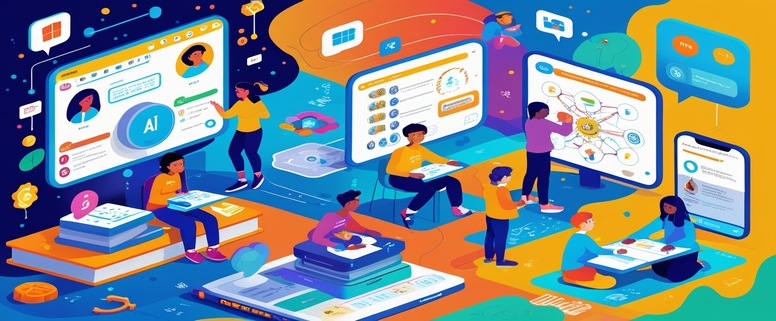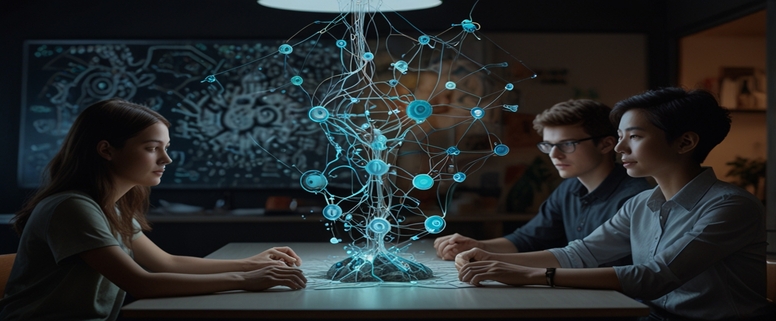Article Information
Category: AI & Education
Updated: March 16, 2025
Author: Emmi C.
Reading Time: 8 min
Table of Contents

AI as an Amplifier for Neurodivergent Minds: A Personal Journey
Updated: March 16, 2025
Introduction: Finding My Path
When I returned to formal education after two decades in the professional world, I faced a daunting reality. The educational system I encountered remained largely unchanged—still designed for neurotypical minds, with standardized approaches that had previously failed me as a dyslexic learner with ADHD. Text-heavy resources, timed assessments, and linear learning pathways presented the same barriers I had struggled with years before.
But something was different this time: I returned with both professional experience and access to emerging AI technologies. Rather than trying to force my neurodivergent mind to conform to traditional educational models, I began exploring how AI could bridge the gap between standardized education and my unique cognitive style. What began as a personal solution has evolved into a broader vision for how artificial intelligence can serve as an amplifier for neurodivergent minds.
The Neurodivergent Experience in Traditional Education
Neurodivergence—including dyslexia, ADHD, autism, and other cognitive variations—remains poorly served by conventional educational approaches. My own experience with dyslexia meant that text-heavy resources required significantly more processing time and energy than for my neurotypical peers. With ADHD, sustained attention on topics that didn't immediately engage my interest became a constant battle, despite having genuine passion for my field.
These challenges aren't indicators of lesser ability but of different cognitive processing. In fact, neurodivergent minds often possess extraordinary strengths: pattern recognition, creative problem-solving, hyperfocus capabilities, and unique perspectives that drive innovation. Yet traditional education rarely accommodates these differences or leverages these strengths.
The statistics reflect this misalignment: neurodivergent students often underperform despite equal or greater intellectual capabilities. In Ireland, neurodivergent students sometimes wait 18+ months for essential support services. Even when support is available, it typically focuses on compensating for perceived deficits rather than enhancing inherent strengths.
My AI Toolkit: Personalized Learning Support
My journey began with creating simple AI tools tailored to my specific learning needs. As someone with dyslexia, I first focused on text processing utilities that could:
Dyslexia-Focused Tools
- Transform Dense Text: Convert lengthy academic papers into structured, keyword-focused summaries with enhanced visual organization
- Develop Conceptual Maps: Generate visual representations of complex ideas to leverage my strong visual-spatial processing
- Create Multi-Modal Learning Resources: Transform single-format information into multiple formats (text, audio, visual diagrams) to reinforce understanding through different cognitive channels
For my ADHD-related needs, I implemented:
ADHD-Focused Tools
- Focused Question Generation: Create targeted questions about study materials to maintain engagement and active learning
- Chunked Learning Modules: Break down comprehensive topics into optimally-sized segments that work with—not against—attention fluctuations
- Hyperfocus Channels: Design learning pathways that connect technical content with my areas of intense interest, creating engagement bridges
These personalized tools became my cognitive scaffolding, allowing me to engage with educational content in ways that worked with my neurodivergent traits rather than against them. The results were transformative: material that once required exhausting effort became accessible, and concepts that seemed impenetrable became clear when presented in formats aligned with my cognitive strengths.

Beyond Accommodation: Amplifying Neurodivergent Strengths
As my understanding of AI capabilities expanded, I realized these technologies offered more than just accommodation—they could actively amplify the unique strengths associated with neurodivergent thinking. This shifted my approach from compensation to enhancement:
Pattern Recognition
AI tools can highlight conceptual patterns across different subjects, making connections that leverage the pattern-seeking strengths many neurodivergent individuals possess. These tools don't simplify content—they reorganize it to match neurodivergent cognitive strengths.
Hyperfocus Capabilities
Rather than fighting against attention fluctuations, AI can identify optimal engagement periods and present challenging material during these windows, while scheduling review and reinforcement during less focused periods.
Non-Linear Thinking
Traditional education presents material in rigid, linear sequences. AI can create flexible, interconnected learning pathways that accommodate the non-linear thinking common among neurodivergent learners.
This approach doesn't lower standards or expectations—it raises the ceiling on what's possible by aligning educational experiences with neurodivergent cognitive styles.
The Science Behind the Results
Research now confirms what my personal experience suggested: properly designed AI tools can dramatically improve educational outcomes for neurodivergent learners. Studies indicate potential comprehension improvements of up to 40% for neurodivergent students when using AI systems tailored to their specific cognitive styles.
This substantial improvement stems from several factors:
Key Factors in Neurodivergent Learning Improvement
- Cognitive Load Optimization: By presenting information in formats aligned with individual processing strengths, AI reduces the cognitive overhead required to translate between formats, freeing mental resources for actual learning.
- Engagement Amplification: Personalized content maintains higher engagement levels, particularly crucial for ADHD learners who experience significant performance variations based on interest and engagement.
- Adaptive Pacing: AI systems can adjust the presentation rate of information based on real-time comprehension signals, preventing the frustration and disengagement that occurs when content moves too quickly or too slowly.
- Multimodal Reinforcement: Research in cognitive science demonstrates that information presented through multiple complementary channels creates stronger neural pathways, particularly beneficial for dyslexic learners who may struggle with single-format presentation.
These benefits extend beyond academic performance to impact self-efficacy, reduced anxiety, and improved learning persistence—all critical factors for educational success.
Building Bridges, Not Bypasses
It's important to emphasize that effective AI tools for neurodivergent learners don't bypass educational challenges—they build bridges across them. The goal isn't to avoid difficult material but to make it accessible through cognitive pathways that work for neurodivergent minds.
For example, my dyslexia-friendly AI tools don't eliminate text; they transform how text is processed and integrated with other information formats. My ADHD-focused tools don't reduce content complexity; they restructure engagement patterns to maintain focus on complex topics. This distinction is crucial: these technologies aim to meet the same high educational standards while creating alternative pathways to mastery that work with diverse cognitive styles.
From Personal Solution to Educational Vision
What began as personal learning tools has evolved into a comprehensive vision for education. The "Learning is Fun" platform and specialized tools like MathSage represent systematic implementations of these principles, designed to serve diverse neurodivergent profiles at scale.
These systems employ several key approaches:
Key Implementation Approaches
- Cognitive Style Mapping: Identifying individual learning patterns to tailor educational experiences based on the PromptSage Framework
- Adaptive Content Transformation: Automatically converting materials into optimal formats for different cognitive styles
- Strength-Based Pathways: Creating learning routes that leverage natural cognitive strengths
- Metacognitive Development: Helping students understand their own learning processes and self-advocate for their needs
These approaches don't require completely rebuilding educational content—they involve restructuring how existing knowledge is presented, accessed, and engaged with.

The Future of Neurodivergent Education
Looking ahead, the potential for AI to transform neurodivergent education extends far beyond current implementations. Emerging technologies will enable:
Advanced Detection & Environments
- Real-Time Cognitive State Detection using subtle engagement signals
- Immersive Multisensory Environments that engage multiple cognitive pathways simultaneously
Personalization Advances
- Collaborative Filtering for Cognitive Styles to predict effective learning approaches
- Self-Evolving Personalization systems that continuously refine their understanding of individual learning patterns
These advancements will further close the gap between standardized education and the rich diversity of human cognition.
Conclusion: Unleashing Neurodivergent Potential
My journey from struggling with traditional education to creating AI-enhanced learning environments reflects a broader shift in how we might approach neurodiversity. Rather than viewing neurodivergent traits as deficits to be overcome, we can recognize them as different—and often powerful—ways of processing information.
Artificial intelligence offers unprecedented opportunities to align educational experiences with these diverse cognitive styles. By creating systems that adapt to individual minds rather than forcing minds to adapt to standardized systems, we can unleash the full potential of neurodivergent thinkers. This perspective aligns with my broader Reflections on Humanity and AI.
This isn't just about improving academic outcomes—though the projected 20-25% improvement in performance metrics is significant. It's about recognizing and nurturing the unique perspectives, problem-solving approaches, and creative insights that neurodivergent minds bring to our collective human endeavor.
As someone who has experienced both the challenges of traditional education and the possibilities of AI-enhanced learning, I see a future where neurodivergence is no longer a barrier to educational success but a different—and valued—path to excellence.




